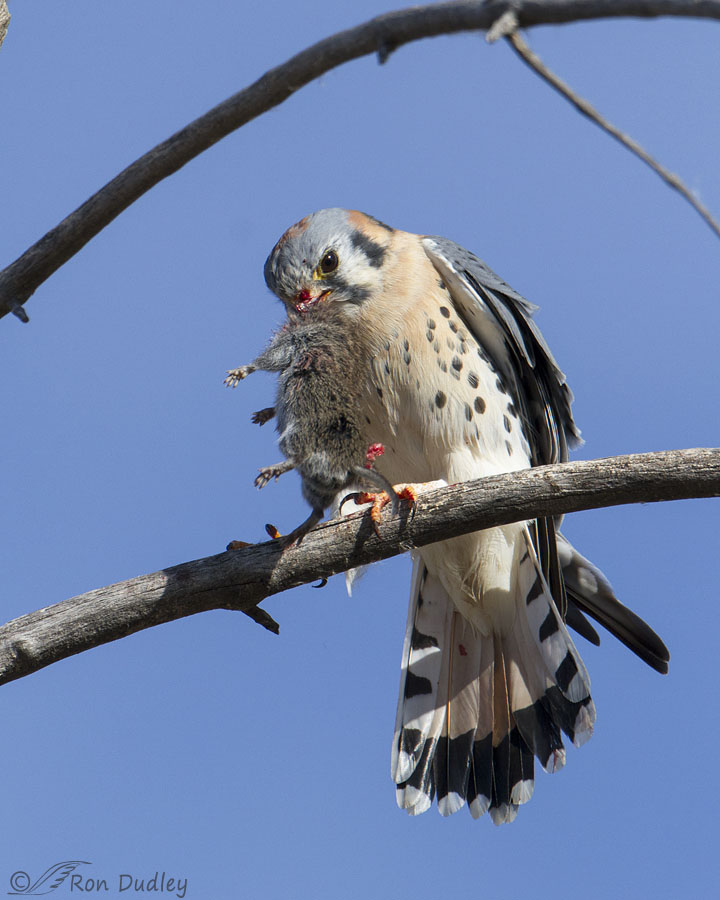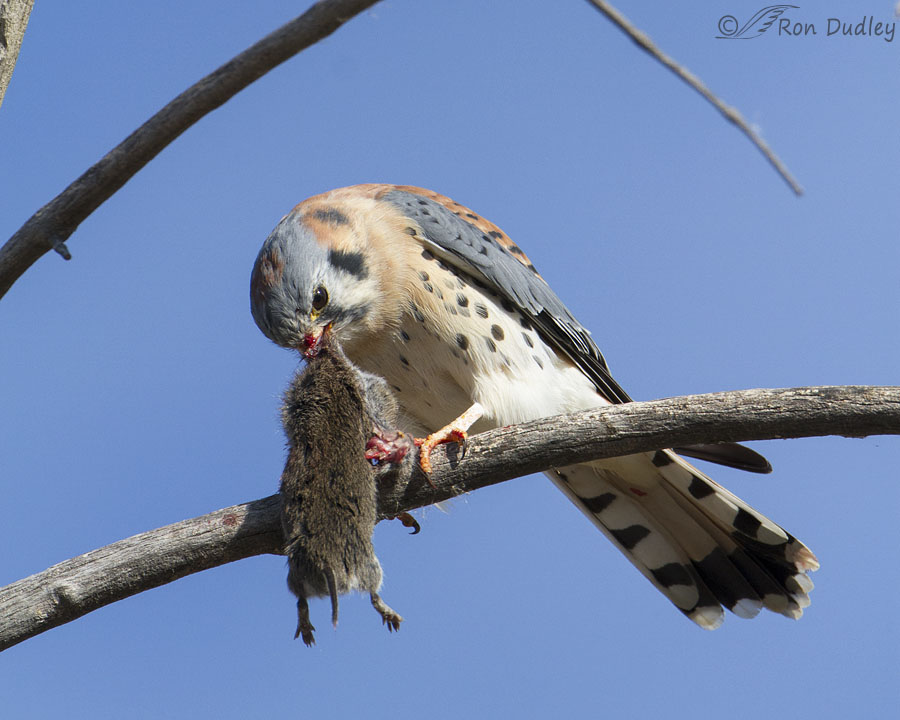Just holding onto your lunch isn’t always easy when you’re 20′ in the air and the prey is relatively large.
I photographed this male American Kestrel feeding on a vole at Farmington Bay WMA three years ago. I never posted these images before in part because the branch over the bird’s head really annoys me but when I found them again last night I decided to overlook the damned thing because I like the behavior.

1/1600, f/8, ISO 500, Canon 7D, Canon EF 500mm f/4L IS II USM + EF 1.4 Extender, not baited, set up or called in
He’d already been feeding on the vole for some time when this photo was taken but he was often struggling to keep it from falling to the ground. This particular vole is fairly large and awkward prey for the small falcon to manipulate and in this shot he’d picked it up off the branch to reposition it.
Obviously his bill is a mess of blood and flesh.

1/1250, f/8, ISO 500, Canon 7D, Canon EF 500mm f/4L IS II USM + EF 1.4 Extender, not baited, set up or called in
Believe me the backside of the rodent is in a lot better shape than its front so I’ll spare you those images due to their graphic nature. After this shot was taken he took off with the vole, presumably to find a larger and flatter table to dine from.
FYI – there are many species of voles and several local mouse species but voles can generally be distinguished from most mice by their stubby tails. I only remember a single instance of seeing a kestrel with a mouse at Farmington but I’ve seen them with a lot of voles.
However on one occasion I also photographed a Barn Owl at Farmington with a mouse so there are at least some mice in the area.
Ron


Wonderful shots, branch and all.
Charlotte
What a spectacular male Kestrel. His two outer tail feathers are more dramatically striped black and white than any I’ve seen here in California.
Interesting observation about the tail, Sallie. Thanks.
I am so very grateful that my food doesn’t bleed on me. I make enough mess as it is.
The pint sized assassins are incredibly beautiful bird (except to their prey). Thank you. And I am sorry to note in the comments that the medical mayhem continues in your life.
“I am so very grateful that my food doesn’t bleed on me”
Ha, I am too, EC!
Thankfully, some of the medical issues have improved.
I am thrilled to read that at least some of your medical issues are in retreat.
Thankfully, some of the medical issues have improved.
That’s great news, Ron!
Amazing shots, and thank you for sparing us the more graphic images. I always love your kestrel posts, they’re such beautiful birds. Living on former farmland that still has plenty of open space, I’d expect to see one from time to time, but I have never knowingly seen a kestrel in the wild. Maybe just not observant enough.
On another note, thanks for settling a discussion between my spouse and me. I told him that short-tailed, furry, little varmint we dispatched from our house last winter was a vole! 😊
I’m glad you found that discussion helpful, Robyn. Thanks.
Yes, just a tad gruesome so appreciate not seeing the other images. 😑 Kestrels have never heard that saying, “Pick on someone your own size!” Hope he managed to hang on to his meal.
I hope so too, Chris. A kestrel I saw this morning lost his meal.
Interesting photos and behavior. That vole is large for the size of the bird. As usual, I’m very happy seeing an American Kestrel.
Me too, Susan. I tried to photograph a male kestrel this morning but he was too far away.
I have had many Mondays like that vole.
I don’t think that vole had any more of them, Martha…
😉
Around here, the kestrels are vying for territory. .
Thst vole looks almost as big as the bird’s body!!! I wonder how much of it that cute Assassin was able to eat….(I hope your visit to the doctor was positive).
My doctor visits are never positive, Patty…
Don’t like the sound of that…wish it were not that way, good person…
Wow, that is a gruesome picture Ron, but I guess we would look a little bloody too if we had to catch our own food. That is a big vole. I have a picture of a kestrel with a field mouse, but one who was smaller and much easier to handle. Excellent photography in spite of the blood and branches.
Everett Sanborn, Prescott AZ
Thanks, Everett. I haven’t seen many larger than this one.
I am impressed you resisted the urge to clone that branch out. You’ve made me a lot more sensitive to annoying branches. 😀 But it was worth it for the vole…it/he/she (grin) was a whopper! Maybe kestrels prefer McVole while owls are Burger Mice fans.
“I am impressed you resisted the urge to clone that branch out”
Thanks for noticing that, Arwen. I was certainly tempted, especially because in many of my other shots of this bird the kestrel was standing more erect so the top of his head was VERY close to the branch. It would have been an easy clone job too…
He did have a “meal” on his talons/beak! Some of the voles here are up to 3″ long without the “stubby” tail and would be a challenge for the little predator for sure! Interesting here as the cats will kill the voles but rarely eat them – mice OK Upper branch does complete the “frame” 🙂
Judy, the “small rodent picture” can get confusing for ID for non-experts like me because besides mice and voles there’s also several shrew species they can be confused with if we’re not careful. I wonder why your cats will eat the mice but not the voles…
Don’t know why the cats won’t eat them – has been that way for the 30 years I’ve been out here – not all related cats over generations so much be something else.
When I visited Alaska 30 some years ago, my brother in law Wade found a pair of voles for us to look at. (He is amazing at turning up the animal or snake of his choice.) I have a very fuzzy photo of them at the bottom of a Dixie cup, and they were not bigger than a quarter around. When I see pictures like these of larger ones, I am baffled! I’m going to have to ask him if those were babies.
Mary, in my experience vole size varies a lot with individuals, age and species. One mammal field guide I have (Audubon) lists 17 North American vole species.
Wade says they were adults. I shared your blog with him, I think he’ll enjoy it.
I like the top branch because it helps to frame the scene. The jury was out on the twig, but since it is parallel to the Kestrel’s body, I’ve decided it can stay. 😋
He’s a gorgeous boy and I’ll bet the vole weighs almost as much (or more!) than he does.
Thanks, Marty. Nothing you can say will convince me to see that branch as one of the ‘good guys’! 🙂
They certainly do enjoy their voles. Judging from the ‘blood spot’ on the Kestrel’s head the vole may not have surrendered easily. I always wonder why these little guys take their lunch upwards and not enjoy it on the ground…must be some reason. (That wayward branch does not interfere with these action photos at all.)
Kathy, kestrels of both sexes usually have a rufous crown on top of their head so I don’t think that’s blood up there.
On the ground they’d be pretty vulnerable to attack from above (and have to be concerned about attack from predators like weasels) and they can take off more easily and quickly from elevated perches (especially with heavy prey) so I imagine that has something to do with it.